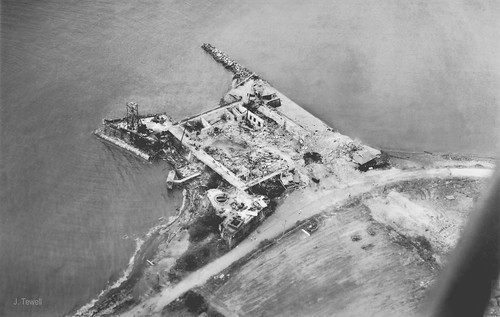US Army 40th Division photo of old Spanish Fort San Pedro, Iloilo City, Panay Island, Philippines, 1945
Image by John T Pilot
This photo shows the damage caused by US planes that bombed the old fort as Japanese forces occupied it. This was all out war but I still wonder about the Japanese and the Americans little respect for the heritage of the Philippines.
This original photograph is in my personal collection
Fort San Pedro or Fort Nuestra Senora del Rosario is found on San Pedro Drive, Iloilo, in the domestic port. The fort was built sometime between 1603 and 1616. Measuring 60 by 60 meters the walls are made from Guimaras rocks and coral stones from the Panay Coast. Originally built to protect the city from Moro and Dutch pirates the fort was a welcomed protection. It wasn't until the 20th century that it faded into disrepair and destroyed in WWII. Recently a park replaced the old historic fort with a statue of Christ showing where the old fort once stood. Fort San Pedro serves as a great spot to spend the night with family and friends, watching the sunset and rise and eating "inasal" or chicken barbeque.
www.what-to-do-in-the-philippines.com/iloilo/fort-san-ped...
Friday, April 15, 2011
FORT SAN PEDRO: Reviving Iloilo’s historic landmark
allaboutiloilophilippines.blogspot.com/2011/04/fort-san-p...
THE centuries-old Fort San Pedro is one of Iloilo City’s historical landmark. It has, however, deteriorated thru years of neglect.
Now, there is a move to restore Fort San Pedro and develop it into a tourist spot.
TIMELINE
• 1603-1616 – Inclusive years when the Spanish government constructed La Fuerza de San Pedro (Fort San Pedro) on a 2,564-square meter property at the Iloilo City waterfront for defense against Dutch and English invaders. The materials used for the fortress were earthworks and wood palisades.
• 1617 – A Dutch squadron of 10 warships engaged the Spanish defenders manning the fort. The Dutch lost the battle.
• 1738 – The Spanish government reconstructed Fort San Pedro, using 30-feet thick stone walls and installing 50 guns and mortars.
• 1899 – Invasion of the Fort by American invaders. At first, the Fort defenders repelled the invaders. On another day, however, a reinforcement of American marines forced the surrender of Spanish defenders. The Fort became a stronghold of the US Navy.
• 1937 – The US Navy turned over Fort San Pedro to the Philippine Army, which turned it into its headquarters.
• 1941-1945 – During World War II, the invading Japanese forces drove the Army out and took over Fort San Pedro, which also served as dungeon for arrested Filipino guerillas.
• March 1945 – Combined forces from the United States Navy and the United States Air Force bombed all Japanese installations in Iloilo City, including Fort San Pedro, which literally perished.
• May 4, 1986 – Consorcia B. Cordova of La Paz, Iloilo City filed a miscellaneous lease application with the Department of Environment and Natural Resources (DENR) for occupancy of Fort San Pedro and establishment of a drive-in restaurant thereat.
• July 10, 1986 – The DENR issued an investigation report recommending the issuance of lease contract to Cordova.
• May 21, 1991 – Cordova and the DENR entered into a 25-year miscellaneous lease agreement – for period covering February 13, 1991 to February 12, 2016 – for use of the property as a drive-in restaurant, the Fort San Pedro Drive-in at the annual rental fee of P36,783.68.
• July 22 and September 18, 1991 – Consorcia Cordova and her husband, Carlos Cordova, died, respectively.
• July 5, 1994 – Transfer of lease contract from the late Consorcia Cordova to her heirs.
• April 14, 1998 – The Department of Tourism (DOT), through Regional Director Edwin Trompeta, wrote a letter to then DENR Regional Executive Director Raoul Geollegue in connection with DOT’s intention to restore Fort San Pedro as a tourist destination. Before it could act on the DOT proposal, however, the DENR had to rescind the lease contract with the children-heirs of the late Corsorcia Cordova. The DENR withdrew the rescission after the heirs contested it in court.
• October 13, 1998 – Trompeta wrote a letter to then Philippine Ports Authority-Iloilo Manager Christian Santillan requesting the PPA to provide a 30-meter buffer zone out of its reclaimed area for conservation of the existing remains of the Fort.
• May 11, 1999 – Trompeta submitted to Sen. Franklin Drilon the preliminary study/design of the proposed Fort San Pedro Conservation Project done by the United Architects of the Philippines, Iloilo Marikudo Chapter.
• January 31, 2003 – The DENR, represented by then Regional Director Raoul Geollegue, signed a memorandum of understanding with the Cordovas reinstating the latter’s occupancy of the leased Fort until expiration date on February 12, 2016; or, in case of rehabilitation of the Fort before that date, a portion of it for restaurant.
• October 2, 2004 – The DENR formally turned over to the DOT the management of Fort San Pedro through a memorandum of agreement signed by DENR Regional Director Vicente Paragas, DOT Regional Director Edwin Trompeta and the heirs of ConsorciaCordova.
• September 15, 2010 – Trompeta wrote a letter to DOT Secretary Alberto Lim requesting for a budget of P100 million for the restoration of Fort San Pedro, which has already been certified by the National Historical Institute as a “historical structure.” It would house a museum, a marine aquarium, a restaurant, a curio shop, an information office and an open-air venue for art and cultural performances.
Sunday, February 10, 2013
US Army 40th Division photo of old Spanish Fort San Pedro, Iloilo City, Panay Island, Philippines, 1945
Subscribe to:
Post Comments (Atom)
No comments:
Post a Comment